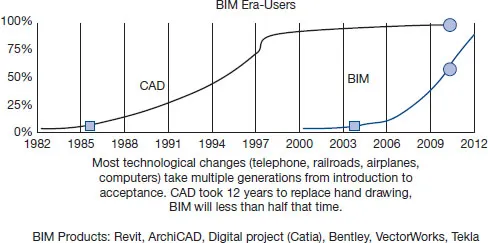![]()
part I
BIM As Though People Mattered
In Part I, you will uncover mistaken beliefs surrounding BIM and its social benefits. Here you will explore the most commonly encountered obstacles to successful collaboration, as well as the challenges this technology and process create for individuals and organizations in their initiatives toward a comprehensive, successful adoption and implementation. You will discover the social implications of working in BIM for individuals and firms and how to overcome real and perceived barriers to its use.
Read these chapters to discover proven strategies for managing the disruptive change brought about by BIM, how to assess your team’s progress, and how to own not only the software but also the process. You will learn about the recent proliferation of BIM-related professional titles and roles, the current state of transition of the industry from CAD to BIM, and what the real distinctions are between BIM-, CAD-, and IT-related roles, including distinctions between BIM managers, CAD managers, and IT managers. In this part, you will read about a design firm that struggled with adopting BIM, only to find itself growing through the recent downturn, thanks in large part to its attitudes and approach to BIM. You will also learn how firms have successfully implemented BIM, from the varying perspectives of a consultant with extensive experience working in BIM with designers, a clinical and organizational psychologist who works with design and construction professionals who are contending with constant change, and a firm owner who has strategically and successfully worked with BIM since the application’s inception.
![]()
chapter 1
What You Adopt When Adopting BIM
Adopting BIM. Good or bad idea? Is there even a choice? Should you wait until they work out all the kinks and it becomes easier to learn and less cumbersome to use? Should you hold out until it becomes a more intuitive design tool?
Your firm is considering BIM or has already acquired the 3D software, perhaps is even using it to some degree and making strides. Why read a chapter on BIM adoption? Why refamiliarize yourself with BIM’s many benefits? We’re sold, you say. Can’t we finally move on? Why read about the challenges, roadblocks, impediments, and hurdles that stand in the way of a full, successful BIM adoption for you and your organization? Anyone working in BIM must be well aware of these. Right?
It all depends on what is meant by BIM adoption. Too often it just means purchasing software, implementing, and moving on.
Read this chapter first—even if you are already working in BIM—because you need to understand the full implications and impacts on the people you work with and for, or who work for you, as well as those impacts on the profession and industry you are an important part of—not only in business and technology terms, but also in terms of how you and your organization have been impacted socially and culturally by the new work processes the industry is currently absorbing in response to the latest software (see Figure 1.2).
—Dennis Neeley, AIA Convention, 2009
There is a larger impediment to the full, speedy, and widespread adoption of BIM by the design professions, and that has to do with the social impacts of the technology on individuals, organizations, and even the profession. You can be assured of a much smoother entry to this new technological process by understanding the social—communication, collaboration, and culture—impacts on your firm. As Autodesk’s Phil Bernstein asks, “The productivity and economic benefits of building information modeling (BIM) to the global building industry are widely acknowledged and increasingly well understood. Further, the technology to implement BIM is readily available and rapidly maturing. Yet despite the obvious benefits and readiness of BIM software, BIM adoption has been slower than anticipated. Why?”1
In this chapter we will take a look at a design firm that struggled with adopting BIM—only to find itself growing through the recent downturn, in large part due to its attitudes and approach to BIM adoption. We’ll cover not only BIM’s technical and business benefits but also its social benefits, as well as the challenges to individuals and organizations that this process creates. This chapter closes with proven strategies for managing this disruptive change. Whether you are new to the BIM world or have been working in BIM for some time, you may not be getting the best and highest use—and return on investment (ROI)—of this phenomenon unless you consider the concepts described and explained in this chapter.
Bogged Down in Detail
BIM adoption and implementation are often used interchangeably, but they are not interchangeable—and part of the reason for failure by firms to fully embrace BIM is because they mistakenly confuse the two concepts.
It is not enough to say BIM was adopted. How was it adopted? By what approach? Top-down or bottom-up? Enthusiastically or begrudgingly? All at once or slow and drawn-out? By a select team, then gradually spread out? Or on all projects from “go”?
Firms that have purchased the software have been getting frustrated with it, bogged down in detail, or have abandoned it altogether after initial pilot projects or efforts. Why is that? (See Figure 1.3.)
Although uptake has occurred quickly, BIM adoption is not widespread among all design professionals, and where adoption does occur it is not sticking in all cases. The big picture—beyond industry announcements to the contrary—indicates that BIM adoption is sporadic, incomplete, and prohibitively shallow. Technological and business adoption has occurred or is currently occurring at the majority of larger firms, but social adoption, and a full understanding of BIM’s impacts on the firm and the individuals that make up the firm, is not. Impacts to the profession—thought to be game-changing—are understood by few and being watched closely by many. Deep, meaningful, and lasting BIM adoption has stalled not because of technological or business factors but because of human factors.
Owning the Process
Where are you and your firm in the adoption process right now? Where do you find yourself along the continuum? You may
- Not have gotten some initial traction—you may have given the software a test run or even ventured into a pilot project.
- Be wondering how to get BIM to stick and become a competitive part of your firm’s future.
- Have installed it and are running with it—but have run into roadblocks, unexpected issues that you would like to resolve effectively.
- Be looking for a clearheaded explanation of what is involved and what impact this technology will have on your practice.
- Be in search of an objective explanation that separates the facts from the marketing hype.
- Own the software but perhaps are not completely utilizing it or are utilizing it less satisfactorily than you had hoped—not for its highest and best use, or to its full advantage. (See Figure 1.4.)
Though BIM use reached the 50 percent mark among design professionals, business leader and author Rex Miller has taken announcements of BIM adoption rates to task. “It is an accurate number,” Miller notes, “if counting the number of architectural firms who have bought BIM software.” Miller continues,




